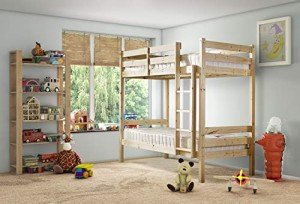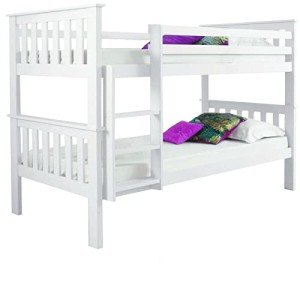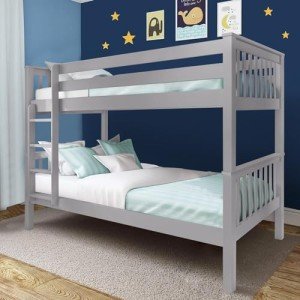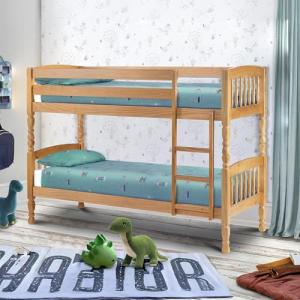Bunk beds have long been a popular choice for maximizing space in children's bedrooms, guest rooms, and even vacation homes. Among the various styles available, white wooden bunk beds with safety guardrails offer a blend of aesthetic appeal, durability, and essential safety features. This guide provides a comprehensive overview of these beds, highlighting their benefits, key considerations, and answers to frequently asked questions.
Aesthetic Appeal
One of the most considerable advantages of a white wooden bunk bed is its timeless aesthetic. White furniture can enhance the overall decor of a room, making it appear more spacious and inviting. Here are some design benefits of choosing a white wooden bunk bed:
- Versatile Style: White complements a variety of color schemes and décor styles, from modern minimalist to classic vintage.
- Natural Brightness: White finishes reflect light, adding brightness to a bedroom, especially in smaller spaces.
- Neutral Base: A white wood bunk bed provides a versatile base that can adapt to changing decor as children grow.
Table 1: Comparison of Bunk Bed Styles
| Style | Aesthetic Appeal | Safety Features | Price Range |
|---|---|---|---|
| White Wooden Bunk Bed | Timeless, versatile, bright | High: Safety guardrails included | Moderate - High |
| Metal Bunk Bed | Industrial, modern | Variable, may lack guardrails | Low - Moderate |
| Fabric Bunk Bed | Cozy, soft textures | Low to moderate | Moderate |
| Wooden Bunk Bed (Dark Finish) | Rustic, warm | Moderate | Moderate - High |
Durability and Functionality
White wooden bunk beds are known for their solid construction. Unlike metal frames, wooden bunks, especially those made from quality hardwoods, tend to be more durable and provide a cozy feel to the room. Specific benefits of wooden bunk beds include:
- Sturdy Construction: Quality wooden bunk beds are often built to last, capable of supporting the weight of multiple occupants without compromising safety.
- Ease of Maintenance: White finishes can easily be wiped clean, and minor scratches can often be resolved with touch-up paint.
- Eco-Friendly Options: Many manufacturers offer sustainably sourced wooden beds, appealing to environmentally conscious consumers.
Key Considerations When Choosing a White Wooden Bunk Bed
When selecting a white wooden bunk bed with safety guardrails, several important factors should be considered:
- Quality of Wood: Look for solid hardwood options like oak or maple rather than particle board or cheap composite materials.
- Guardrail Height and Stability: Ensure guardrails are sufficiently high and securely integrated into the bed design to prevent falls.
- Weight Capacity: Verify the maximum weight limit, especially if the bunk will be used by older children or adults.
- Ladder Design: A fixed ladder offers stability over a removable one and is generally safer for small children.
- Mattress Size: Confirm that the bed accommodates standard mattress sizes for the best fit and comfort.
Safety Guardrails
Safety guardrails are critical components of bunk beds, especially for the top bunk. These features enhance safety by minimizing the risk of falls. Here are a few considerations regarding guardrails:
- Height and Distance: Ensure guardrails extend at least 5 inches above the mattress to provide adequate protection.
- Slats Spacing: Check that the spacing between slats is no more than 3 inches to prevent entrapment risks.
- Material Quality: Guardrails should be made from the same solid wood as the bed frame for a cohesive and stable structure.
Frequently Asked Questions (FAQs)
1. Are white wooden bunk beds safe for children?
Yes, white wooden bunk beds with safety guardrails are designed with safety in mind. Ensure that the bed adheres to safety standards and is equipped with guardrails and a sturdy ladder.
2. What materials are typically used in white wooden bunk beds?
Most white wooden bunk beds are constructed from solid wood, such as pine, oak, or maple. Some may also feature engineered wood components.
3. How do I maintain a white wooden bunk bed?
Regular cleaning with a damp cloth is advisable. For minor scratches, touch-up paint can help restore the finish. Avoid using harsh chemicals that may damage the wood.
4. Which mattress type is best for bunk beds?
A standard twin-size mattress is often recommended for most bunk beds. Memory foam or innerspring mattresses provide comfort while ensuring safety.
5. Can adult guests use a wooden bunk bed?
Many white wooden bunk beds have weight capacities that support adult users. Always check the manufacturer guidelines to ensure they meet your needs.
Choosing a white wooden bunk bed with safety guardrails offers practical benefits that extend beyond mere aesthetics. With their durability, safety features, and timeless design, these bunk beds serve as functional furniture pieces that can grow with children over time. By considering the key factors outlined in this article, parents and guardians can make informed decisions that enhance both the safety and style of their living spaces.
Investing in the right bunk bed will not only foster a safe sleeping environment but also create a delightful retreat for children to enjoy sleepovers, play, and dream.






